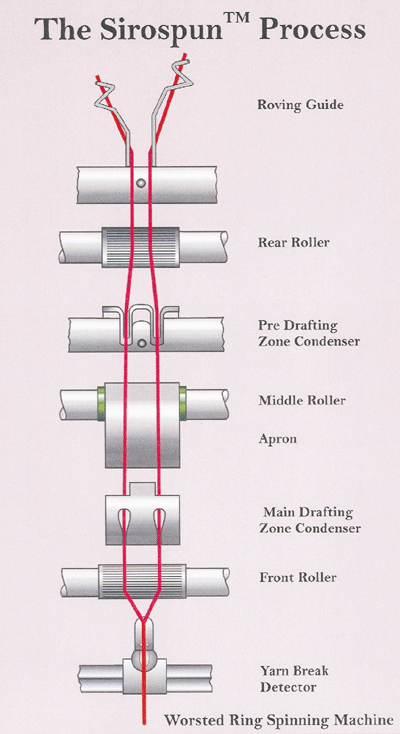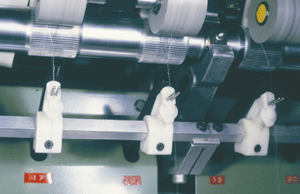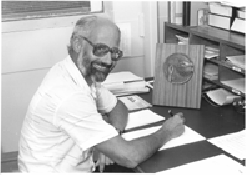Sirospun
The development of Sirospun technology by Dieter Plate and colleagues from the Division of Textile Industry in the 1970s was an important innovation for the global wool textile industry. The original patents were taken out in 1973, 1974 and 1976 and for his role in this development Dieter Plate was awarded a CSIRO Medal for Research Achievement in 1986, the Sir Ian McLennan Achievement for Industry Award in 1988, the Warner Memorial Medal of the Textile Institute in 1990 and the Wool Foundation Eliza Forlonge Medal in 1993.
Traditionally, two-fold yarns are used for worsted weaving, because twisting binds the surface fibres into the structure of the yarn and makes it more resistant to the abrasive forces that occur during weaving. The essence of Sirospun is the combination of spinning and doubling in the one process. At the same time the productivity of the Spinning Frame is effectively doubled. Fabrics produced from Sirospun yarns have a smoother handle than those produced from the traditional two-fold yarns, which made them particularly suitable for the light-weight, ‘Cool Wool’ fabrics being introduced to the trade at the time by the International Wool Secretariat (IWS).
The development was commercialised in 1980 by a consortium comprising the Melbourne engineering company Warren, Brown and Staff, IWS and CSIRO. Sirospun spindles had been installed in Australia, Britain and Germany before the systems formal release in 1980. Twelve years after its commercial release the net world profit from Sirospun was estimated to be $8 billion.
The traditional process of worsted yarn production
Traditional worsted fabric production uses ‘twofold yarns’ which require two stages of production. First a ‘singles’ yarn is spun on a ring-spinning frame and then two of these yarns are twisted together on a twisting frame to produce the twofold yarn. Both of these are relatively low-production, high cost processes, because of physical limitations to the rate at which twist can be inserted. A singles yarn is not suitable for weaving, because the surface fibres of the yarn are not tightly enough bound into the yarn structure to survive the abrasive forces it is exposed to on the weaving loom. In the twofold yarn the surface fibres of each single yarn are continuously trapped between the two yarns and are thus firmly bound into the yarn structure. The twofold yarn can be described as a ‘two-strand’ yarn with twist in each of the individual strands.
In cotton fabric production the abrasion problem of singles yarns is solved by a process known as sizing, in which the surface fibres are literally glued to the surface by passing the yarn through a starch solution. This is a much cheaper process than two-folding, but has not proved suitable for worsted yarns.
First attempts at yarn production in a single step
In 1968 Jim Lappage at CSIRO Division of Textile Industry invented a system of producing a two-strand yarn, that was suitable for weaving in a single operation on a slightly modified spinning frame. This worked by combining the yarns from two adjacent drafting units onto one spindle and periodically moving the convergence points of the two stands up and down. This in fact produced a two-strand yarn with strand twist, but unlike a conventional twofold yarn in which the strand-twist is unidirectional, the strand-twist periodically changed in direction, but was still effective in binding the surface fibres.
Shortly after this Lappage left the Division and the work was taken over by a group led by Dieter Plate. It was soon shown that these yarns suffered from an inherent defect that caused patterning in woven fabrics and made them unsuitable for most end-uses.
Success with the development of Twin-Spin (later renamed Sirospun)
An understanding of the mechanism of formation of this yarn led Plate and Jack Feehan to invent a new method of producing a similar yarn, initially called ‘Twin-Spin’. As Dieter recalled:
Despite this being a simple process the mechanism is surprisingly difficult to understand and even more difficult to explain to other textile scientists

In this method two strands were again combined onto the one spindle, but instead of the convergence point being moved up and down, the convergence point was held in a constant position and the twist reaching the point was periodically varied by a roller with a partial cut-out positioned between the spindle and the convergence point which periodically blocked the twist from reaching the convergence point. This had 2 major advantages, firstly the patterning problem was largely eliminated and secondly the two individual strands could now be much closer together, so much so that both could be produced on the same drafting unit, which in effect doubled the production rate of the spinning frame. Extensive trials of the process were then conducted in the Geelong laboratories.
During these trials a patent search revealed a previous patent in which 2 strands at similar spacing on the one drafting unit, were simply allowed to combine at a free moving convergence point. Theoretically, if both strands were completely even, no strand twist should be generated in this way. However, it was shown that the random fluctuations in strand thickness constantly changed the twist equilibrium, such that a small amount of strand twist was generated. Experiments showed, that while the abrasion resistance of these yarns was significantly worse than that of the twin-spin yarns, they could in many cases, particularly for fine yarns, display adequate weaving performance.
Refinement of the Twin-Spin process
The question now was why this process had not been adopted by industry. Plate and Feehan realised that the answer was, that in the present systems, if one of the two strands broke, the other strand could continue to run for some time. Thus the two-strand yarn could contain sections of single yarn, which would either break during weaving or worse still survive through to the finished fabric. These single sections would be readily visible in the fabric and constitute a major fault, which would be extremely expensive to repair.
The solution to this problem was simple and elegant. They narrowed the cut-out in the twist-blocking roller and modified the convergence guide to allow it to move sideways. Now, if one stand broke, the other strand moved sideways, outside the cut-out, so that twist was permanently blocked, causing the second strand to break immediately. A new generic patent application was filed, which was based principally on the method of breaking the second strand by twist blocking. This patent was eventually granted in all major wool using countries. As Dieter Plate recalled:
One of the highlights for me was, when on a personal visit, I finally managed to convince the German patent office of the novelty and commercial aspects of the Twin Spin patents.

Commercialisation
Introduction of the process to industry was initially delayed because it competed directly with the ‘Self-twist’ process which had been invented by Dave Henshaw and colleagues at the Division of Textile Industry in the 1960s and was currently being commercialised (see also Self-twist yarn). At the beginning of 1976 the first commercial trials of ‘Twin-Spin’ were conducted in the Valley Mill in Geelong. They proved to be very successful, particularly for lightweight men’s suiting and trouser fabrics, because the fabrics were more lustrous in appearance and had a smoother feel than those made from traditional two-fold yarns. The International Wool Secretariat (IWS) then became involved in the international transfer of the technology. A consortium of CSIRO, the IWS and Repco (later to become Warren and Brown) was formed to commercialise the technology. Machines were installed in the UK and Germany for commercial evaluation.
In 1978, following some problems with the original modification to spinning frames, development work by IWS led to a further redesign of the process. This consisted of the elimination of the twist blocking roller and the design of a clever new break-out device. The elimination of the twist blocking roller did not turn out to be a problem, because firstly the original foreign patent for a two-strand yarn had since been allowed to lapse and secondly because the “Twin-Spin†process was now being predominantly used for fine yarns where weaving performance was still good. While the new break-out device still worked by twist blocking and thus fell within the scope CSIRO’s main patent, it allowed IWS to take out a new apparatus patent, which further strengthened the protection of the process.
As Dieter recalled: The break-out device has to be pretty finely balanced. If it can tip over too easily, it can cause the yarn to break even when both strands are present. On the other hand, if too much force is required to pull it over, than a single strand may not be able to generate sufficient force to tip it. The tipping lever sits on a flat ledge, the width of which determines the force required to tip it. We found we had to manufacture two different devices for very fine and for coarser yarns.
Twin-Spin is renamed Sirospun
In 1979 the name of the new spinning technology was changed to ‘Sirospun’ and in 1980 the German manufacturer of spinning frames, Zinser, was licensed to sell Sirospun spinning frames and to convert old frames to the new system. Wool Development International, the commercial arm of the IWS, also became involved in converting old frames and manufacturing the breakout device.
One problem that arose during the adoption of the Sirospun process was knot slippage on the loom, which exacerbated the already lower weaving efficiency of Sirospun yarns. Work in the Division by Dr. Russell Garnsworthy to combat this problem resulted in the invention of the ‘Thermosplicer’, which became commercially available in 1986. This allowed the replacement of knots by splices which were more reliable and generally did not require removal from the fabric during mending. It thus helped to improve weaving efficiency as well as reducing mending costs. By the end of 1990 the commercial installation of Sirospun spindles was estimated to be about 175 000, which was about 7% of world capacity of worsted yarn spindles.
Economic benefit
An independent analysis in 1992 by the Australian Bureau of Agricultural and Resource Economics (ABARE) research estimated the world net profit from Siropsun at that time to be just over $8 billion, and the profit to Australia at $974 million (Johnson B, Tupule V, Foster M, Gilmour K, ‘The Economic gains from Sirospun technology’, ABARE Report 92.5).
Sirospun is especially suited to the production of lightweight, trans-seasonal ‘cool wool’ fabrics and was promoted by IWS for this purpose. The system has two major advantages: the cost of two-folding is eliminated and the productivity per spindle of the ringframe is effectively doubled.

Honours and awards
For his role in the development of Sirospun, Dieter Plate was awarded a CSIRO Medal for Research Achievement in 1986, the Sir Ian McLennan Achievement for Industry Award in 1988, the Warner Memorial Medal of the Textile Institute in 1990 and the Wool Foundation Eliza Forlonge Medal in 1993 for outstanding individual contribution to the Australian Wool Industry.
In connection with the Eliza Forlonge award Dieter commented:
I was particularly pleased to receive this medal, because it was recognition for our work by the Australian Wool Industry. It is a beautiful medal and is based on a bit of fascinating history of the start of the Australian fine wool Industry. The centre piece is a genuine 1827 gold sovereign and the surround is gilt silver.
Eliza Forlonge [1784-1859] was an Australian pioneer who played a large part in introducing merino sheep to the south-east part of Australia. She came from Scotland and travelled through Saxony selecting the best sheep she could find and shipped them to Australia.
Source
- Plate DE, 2009, Personal communication.
